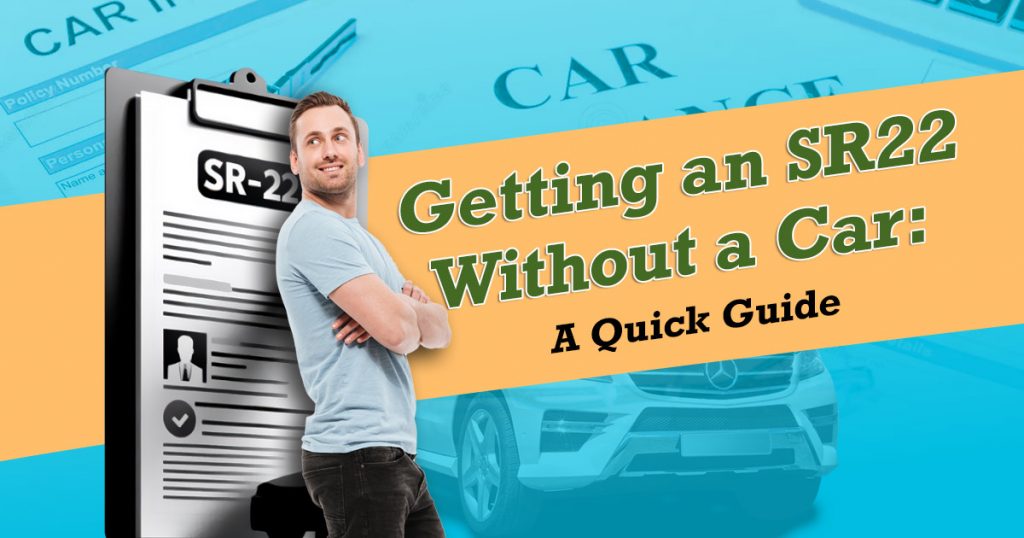Needing an SR22 but not owning a car can be confusing, but getting one is possible with the right steps. This form proves you have the required liability coverage, even if you don’t have a vehicle. It’s often required after certain driving violations, and not having a car doesn’t change that requirement. Understanding how to get an SR22 without a car can help you stay compliant with state laws and keep your driving privileges intact.
What’s an SR-22 Insurance?
SR-22 insurance isn’t a type of policy but a form that proves you have the minimum required liability coverage. It’s filed by your insurance company with the state to confirm you’re meeting legal insurance requirements. Even if you don’t own a vehicle, you may still need this form to keep or reinstate your driving privileges.
Most states require an SR-22 after serious traffic violations, like reckless driving or DUI charges. It’s often necessary for those with suspended or revoked licenses who want to regain their ability to drive legally. If you need an SR-22 but don’t own a car, a non-owner policy can provide the coverage needed to meet state requirements.
When Does a Person Need an SR-22?
Drivers usually need an SR-22 after incidents that label them as high-risk. This includes offenses like DUI or DWI, multiple at-fault accidents, driving without insurance, or excessive traffic violations within a short period. Some states also require it for license reinstatement after suspension.
Not owning a vehicle doesn’t remove the obligation to carry insurance in these cases. If a driver frequently operates borrowed or rented cars, a non-owner policy with an SR-22 ensures they stay covered and legally compliant. It helps avoid further penalties, such as extended license suspension or higher fines.
What if I Don’t Have a Car?
Needing an SR-22 but not owning a vehicle doesn’t mean you can skip the requirement. Many states still expect proof of financial responsibility, even if you don’t drive regularly. In this case, a non-owner insurance policy provides the necessary coverage and allows you to meet state requirements.
This type of policy covers liability when driving a borrowed or rented car, but it won’t include damages to the vehicle you’re using. It’s a cost-effective solution for staying compliant without insuring a specific car. If you need an SR-22 but don’t own a car, this option keeps your license valid and prevents further penalties.
Steps to Get an SR-22 Without a Car
The process of getting an SR-22 without a vehicle is straightforward. Follow these steps to stay compliant:
- Receive a court order or DMV notice – If required, you’ll be notified that you need an SR-22 to reinstate or maintain your license.
- Find a non-owner insurance policy – Look for an insurer that offers this type of coverage and inform them about your SR-22 requirement. Get quotes to compare pricing and coverage.
- Request the SR-22 form and pay the filing fee – Your insurer will file the form with the state, but you may need to cover a small processing fee. Costs vary by provider.
- Wait for state approval – Processing times depend on your state’s DMV, but once approved, you’ll receive confirmation that your SR-22 is on file.
What Does SR-22 Insurance Cover?
SR-22 insurance doesn’t cover damages to your own vehicle but ensures that you meet the minimum liability requirements set by your state. It’s primarily focused on protecting others in case of an accident where you’re at fault. This means it will cover medical expenses, property damage, and any other costs that arise from an accident you cause while driving a non-owned vehicle.
If you need an SR-22 but don’t own a car, this coverage still applies when driving a borrowed or rented vehicle. However, it won’t cover damages to the car you’re driving or your own medical costs. This is why it’s important to understand that while the SR-22 keeps you legally compliant, you might still need separate coverage for additional protection.
Stay Covered and Keep Driving Legally
Having an SR-22 requirement without owning a car might seem tricky, but the right steps make it manageable. A non-owner insurance policy ensures you stay compliant and avoid further penalties. Keeping continuous coverage is key to maintaining your driving privileges and preventing extra fines or license suspension. Taking action early helps you stay on track and worry less about legal issues.
